

Windows Millennium
with Outlook Express
Configurations for CVC Internet, LLC
Please Note: These
instructions are for users
who have experience setting up software programs.
If you notice a difference in
setup windows, please take the general
information listed below and apply them in the appropriate windows.
********************************************************************
DO NOT MAKE
ANY OF THESE CHANGES,
WITHOUT YOUR WINDOWS OPERATING SYSTEM CD/DISKS
*******************************************************************
- Step 1 - Dialup Networking -
1.) When you turn on your computer system, Windows will load a main screen (the desktop). On the main desktop, double-click on the My Computer icon.
2.) In the My Computer window, double-click on the Control Panel icon.

3.) In the Control Panel window, double-click on Dial Up Networking icon (sample window below).
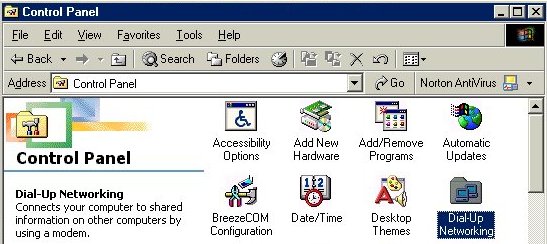
4.) In the Dial-Up Networking window, double-click on the Make New Connection icon
(sample window below).
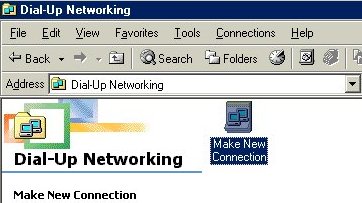
5.) This will bring up a Make New Connection screen that contains two fields.
Insert the following information:
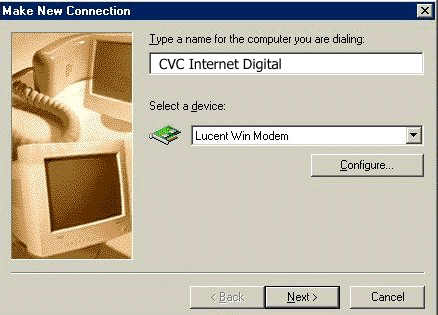
6.) Click on the Configure button under the modem field and lower your modem speed from 115200 to 57600. Click OK to return to the Make New Connection window. (sample screen below)
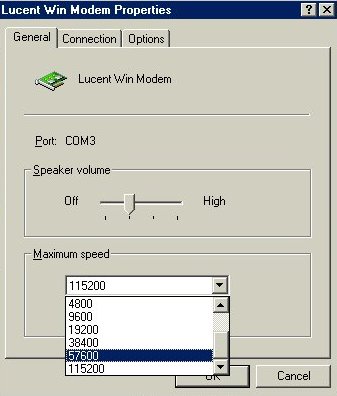
7.) In the Make New Connection window, click Next to continue.
8.) The next screen will list the following fields, enter :
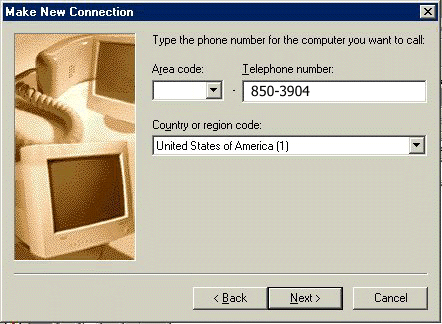
9.) The next screen will indicate, you have successfully created a Dial-up Networking connection called CVC Internet Digital. Down at the bottom of the screen, click on the Finish button (sample screen below).
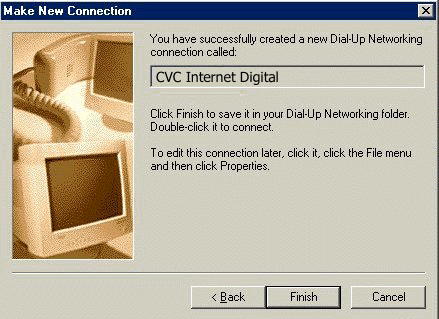
10.) To create your second dialer, in the Dial Up Networking window, double click on Make New Connection.

11.) This will bring up a Make New Connection screen that contains two fields.
Insert the following information:
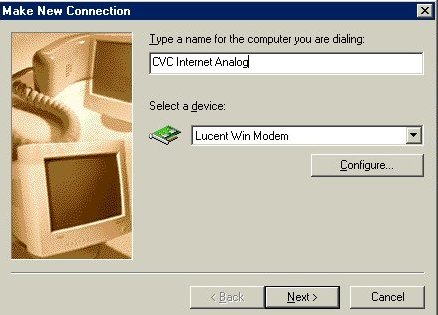
12.) Click on the Configure button under the modem field and lower your modem speed from 115200 to 57600. Click OK to return to the Make New Connection window. (sample screen below)

13.) In the Make New Connection window, click Next to continue.
14.) The next screen will list the following fields, enter :
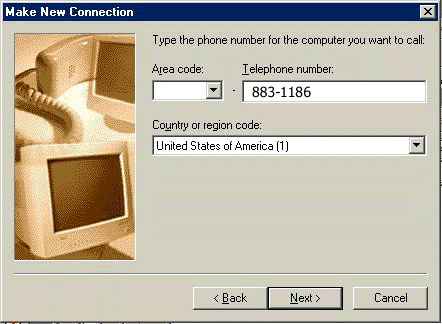
15.) The next screen will indicate, you have successfully created a Dial-up Networking connection called CVC Internet Analog. Down at the bottom of the screen, click on the Finish button (sample screen below).
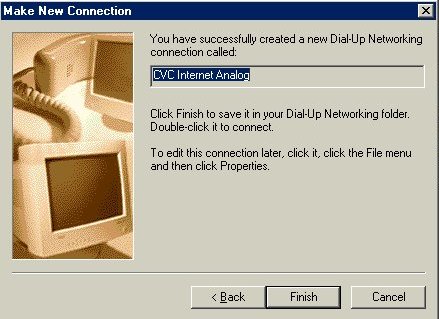
16.) You should now have two CVC Internet icons (one for Analog and one for Digital that look like two computers with CVC Internet underneath) located in the Dial-up Networking window. Single right click on the first CVC Internet icon, and click on Create Shortcut. There will be a window stating "Windows can not create a shortcut here. Do you want to place the shortcut on the desktop instead?" Click Yes. Repeat this with the other dialer.
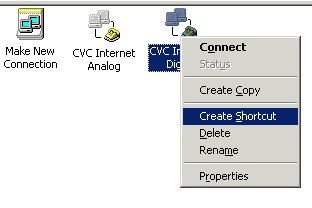
17.) In the Dial Up Networking window, single-right-click on the first CVC Internet icon and select Properties.
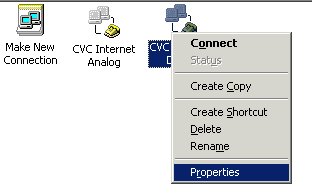
18.) In the CVC Internet Properties window, General Screen, check the following:
a.) Area Code: should be blank.
b.) Telephone Number: should show your
850-3904
(make sure there is no 1
in front of the phone number).
c.) Country Code: should show United States
of America (1)
d.) Use area code and Dial Properties: if you
have this option,
make sure there is a check mark
beside this option.
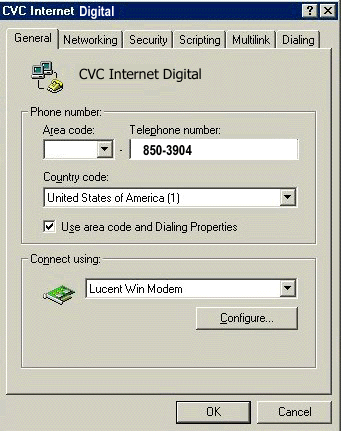
19.) At the top of Properties window, General screen, click on the Networking tab.
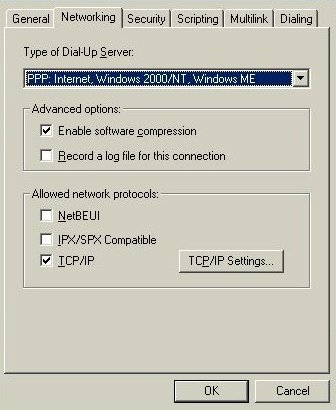
20.) In the TCP/IP screen, select the following items:
Make sure these options are the ONLY items selected in this screen, then click
OK.
(sample screen below)
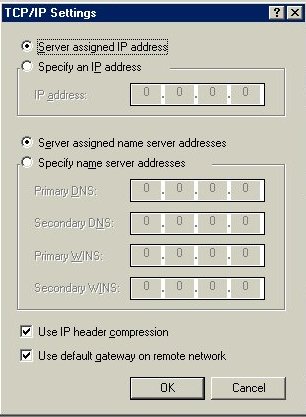
21.) Click on the Dialing tab and make sure the following options are not checked:
Click OK to return to the Dial Up Networking window. Repeat steps 17-21 to check the Properties of the Analog Dialer for the connection number of 883-1186. After checking the second dialer, close the Dial Up Networking window to return to the Control Panel.
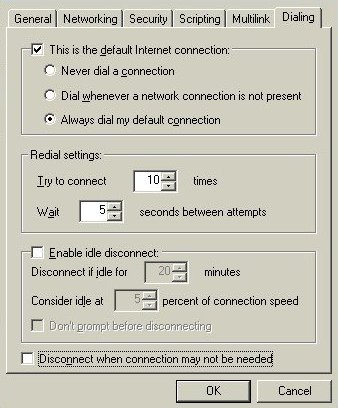
22.) To make sure the Windows Networking is set correctly, follow these steps:
***** DO NOT MAKE ANY OF THESE CHANGES WITHOUT
YOUR WINDOWS OPERATING SYSTEM CD/DISKS! ******
(Disks are needed only if you need to install one of the following components.)
In the Control Panel window, double-click on the Network icon.
In the Network window, Configuration screen, the following items must be installed.
(sample window below)
If the above items are installed, go to step 17.
23.) If Client for Microsoft Networks is not installed, go to
step 28a.
24.) If Dial-Up Adapter is not installed, go to step 29a.
25.) If TCP/IP is not installed, go to step 30a.

26.) Highlight the Dial-Up Adapter, click on Properties, then click on Bindings.
27.) Make sure only TCP/IP is checked, uncheck any other Protocol listed,
then click OK. This will take you back to the Network window, at
the bottom of this window click on the OK button.
Once you are back in the Control Panel window, click on the X at the top right-hand corner of the window (this close the window). And to get back to the desktop, click on the X at the top right-hand corner of the My Computer window.
To finish the dialer setup, refer to Step 20.
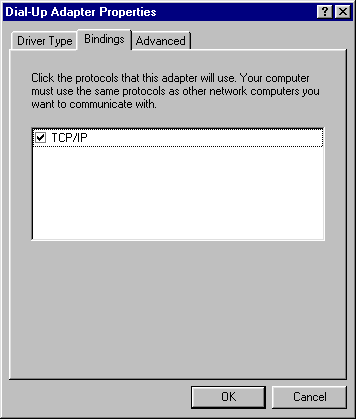
28a.) Click on Add, highlight Client then click on Add again
(sample screen below).
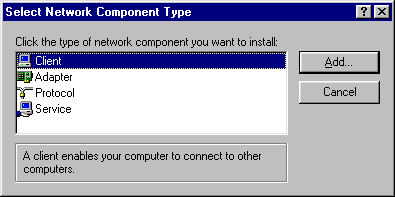
28b.) Highlight Microsoft (in the Manufacturers window), then Client for
Microsoft Networks
(in the Network Clients window), and click OK
(sample screen below).
Return to step 17.
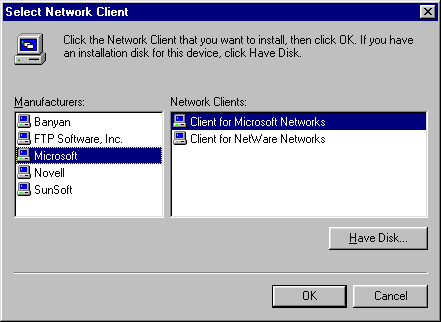
29a.) Click on Add, highlight Adapter and click on Add again
(sample screen below).
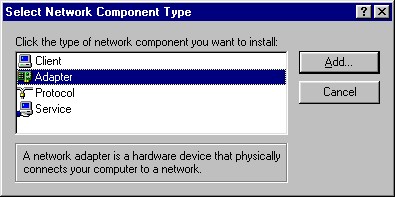
29b.) Highlight Microsoft (in the Manufacturers window), then
highlight Dial-Up
Adapter (in the Network Adapters window), and click OK
(sample screen below).
Return to step 17.
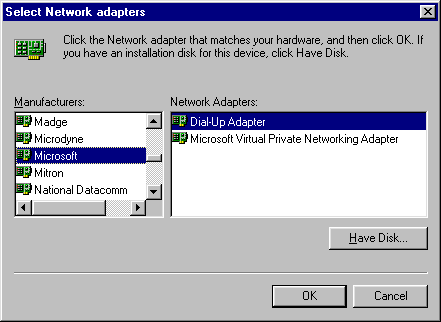
30a.) Click on Add, highlight Protocol and click on Add again
(sample screen below).
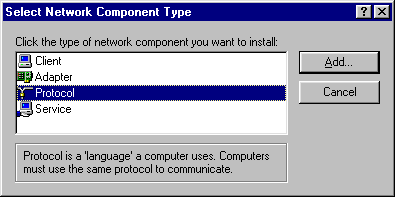
30b.) Highlight Microsoft (in the Manufacturers window), then highlight
TCP/IP
(in the Network Protocols window), and click OK, then return to
step 17.
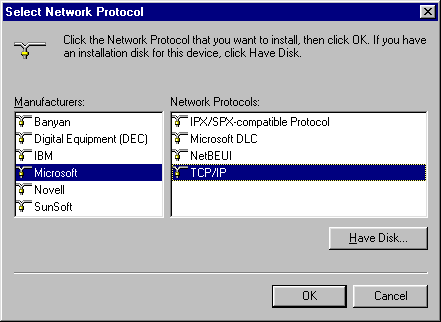
- Step 2 - Browser Configurations -
1.) On the desktop (computer's main screen), double-click on the My Computer icon.
2.) In the My Computer window, double click on the Control Panel icon.
3.) In the Control Panel window, double click the Internet Options icon.
4.) In the Internet Properties screen, select the General tab.
In the General tab screen, Home Page
section, Address box: enter http://www.cvc.net.
At the bottom of the Internet Properties window, click on the Apply button.
(sample screen below)
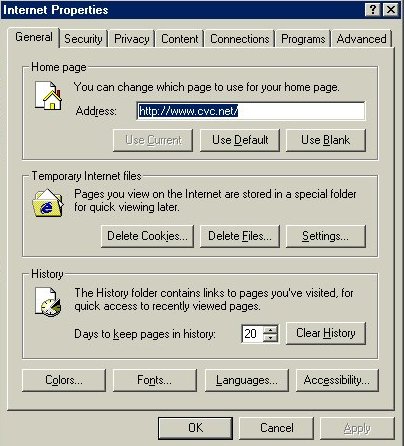
5.) At the top of the Internet Properties window, click on the Privacy tab. In the Privacy screen, click on the Advanced button.
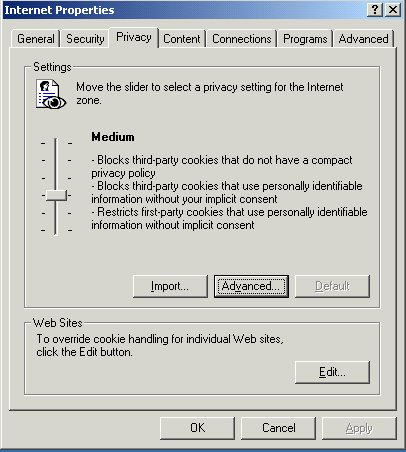
6.) In the Advanced screen, select:
"Override Automatic Cookie Handling"
"Accept - First Party Cookies
"Accept - Third Party Cookies"
"Always allow session cookies"
Click OK at the bottom of the Advanced screen. Click Apply at the bottom of the Privacy screen.
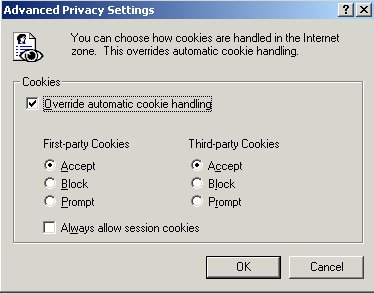
7.) Go to the top of the Internet Properties window, and click on the Connection tab.
8.) In the Connection screen, click on the bullet beside Always dial my default connection. To continue setup, click on the Settings button.
(sample screen below)
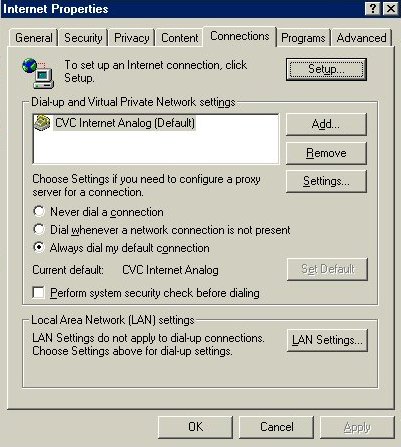
9.) In the Settings screen at the bottom of the screen, enter the following items:
In the Dial Up Settings box, User name box: enter your CVC Internet username (in lowercase, Do Not add @cvc.net).
In the Password box: enter your CVC Internet password (in lowercase).
In the Domain box: leave this box empty.
At the bottom of the Settings screen, click on the OK button. At the bottom of the Internet Properties window, click on the Apply button, then OK.
Back in the Control Panel, close the window with the "X" in the top right corner.
(sample screen below)
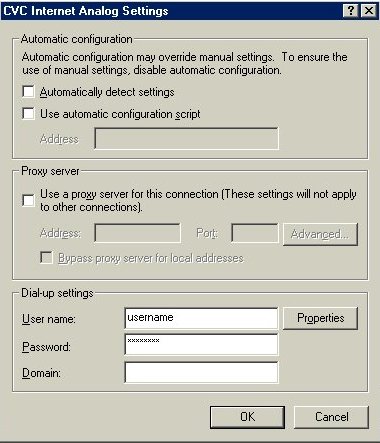
- Step 3 - Mail Configurations -
2.) If a Connection Wizard or a Connect To Window appear, cancel it.
3.) Click on the Tool Menu (at the top of the Outlook
Express window),
and select Accounts (see sample screen below).
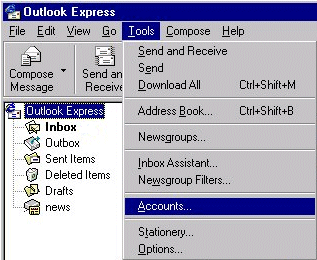
4.) In the Internet Accounts screen, click on the Mail Tab.
5.) If you have a existing account listed in the Mail window, highlight
it with a single
left mouse click, then click the Remove button. When a
window appears asking
you if you want to remove the account, click Yes.
6.) Next, click the Add button (on the right-hand side of the Internet Accounts window), and select Mail (see sample window below).
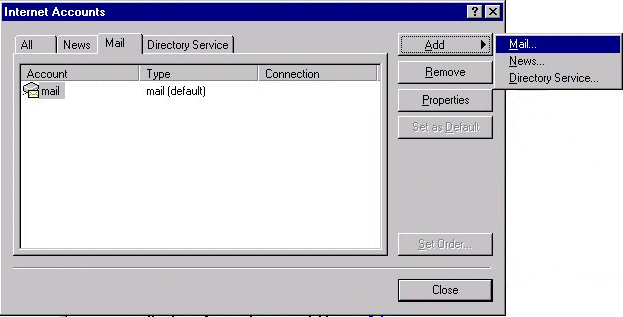
7.) In the next window, enter in your real name in the Display name
box, then
click on the Next button (at the bottom of the screen, sample window
below).
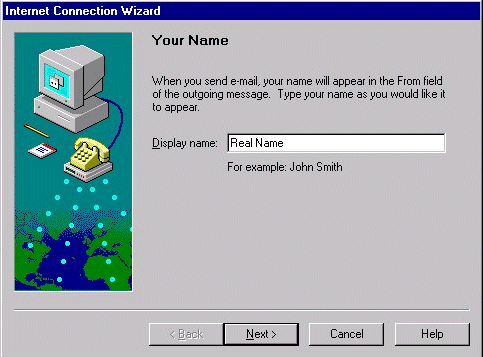
8.) In the next screen, enter in your e-mail address (in
lowercase characters),
then click on
the Next button (at the bottom of the screen, sample window below).
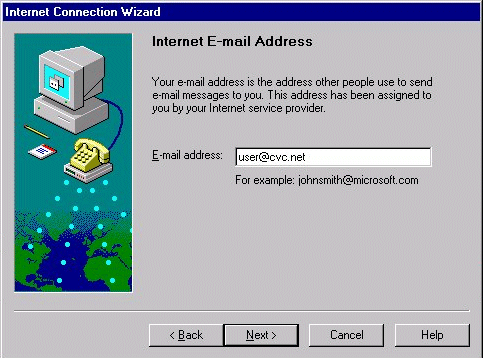
9.) In the next window, complete in the following (see sample window below):
Click on the Next button (on the bottom of the screen).
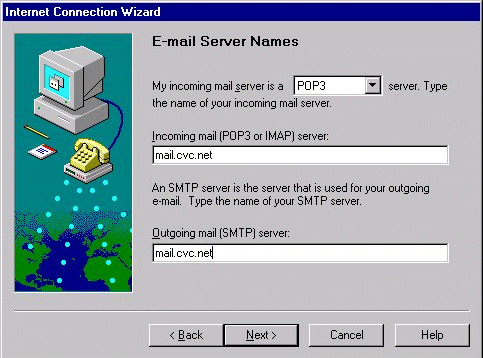
10.) In the next screen, Internet Mail Logon, complete the following:
Click on the Next button (at the bottom of the screen).
(sample screen below)
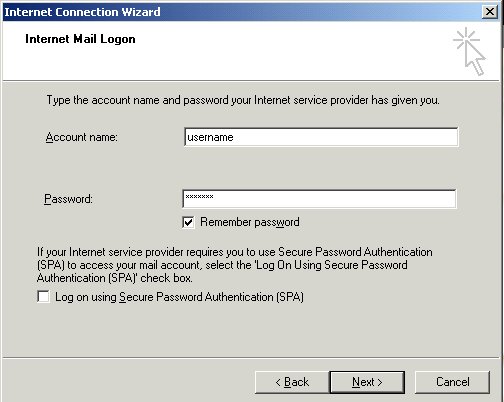
11.) In the next window, click on the Finish button.
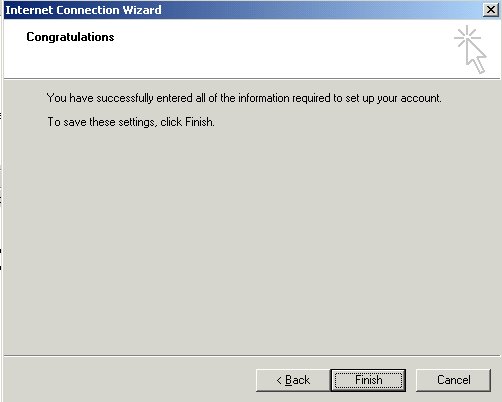
Your done! For information on using e-mail or browsing the Internet,
refer to the Help Menu
located within the software program.
- Step 4 - Checking Your E-mail Properties -
1. At the top of the Outlook Express window, click on the "Tools" menu and select "Accounts".
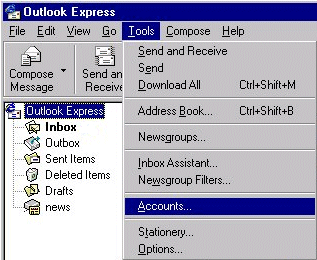
2. At the top of the Internet Accounts screen, click on the "Mail" tab. Click once on the mail account so it becomes highlighted, then click on the "Properties" button (right side of the screen, third button down).
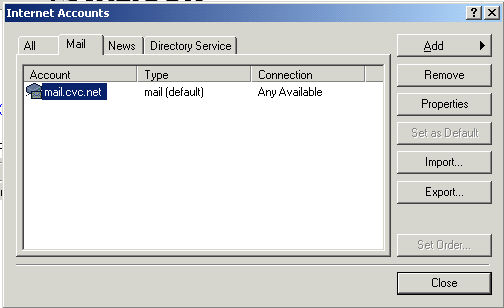
3. In the Properties window, "General" screen, verify the following settings:
Mail Account - Should contain the mail server addressing for your e-mail account (example shown below).
Name - Should contain your real name or business name.
Organization - Optional Setting, this field can contain your organization's name.
E-mail Address - Make sure the correct e-mail address is showing (example shown below).
Reply Address - Optional Setting, this field can contain your e-mail address, but make sure the address is correct.
Include this account when receiving mail or synchronizing - This setting should be selected (check marked).
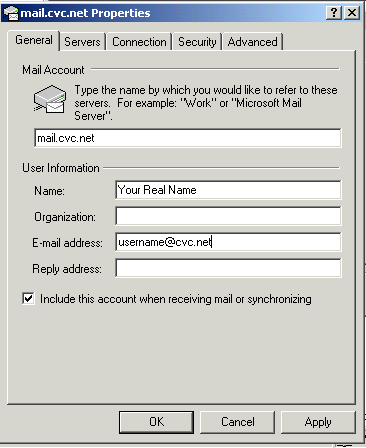
4. At the top of the Properties window, click on the "Servers" tab and verify the following settings:
My Incoming mail server is a: POP3 sever should be showing.
Incoming Mail (POP3): This setting should contain the mail server addressing assigned to your e-mail account (example shown below).
Outgoing Mail (POP3): This setting should contain the mail server addressing assigned to your e-mail account (example shown below).
Incoming Mail Server, Account Name: This should contain your mailbox username.
Incoming Mail Server, Password: This should contain your mailbox password.
Log on using Secure Password Authentication: Should not be selected.
Outgoing Mail Server, My Server Requires Authentication: This option should be selected.
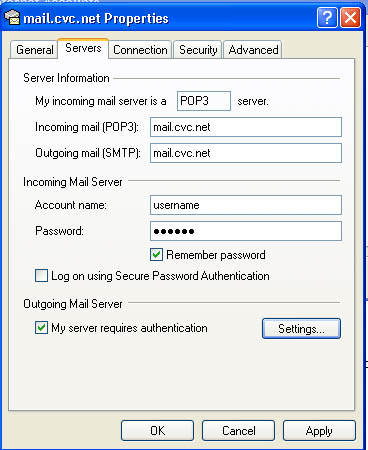
5.) At the top of the Properties window, click on the "Connection" tab. In the Connection screen, make sure "Always connect to this account" using is selected and that "CVC Internet" is showing in the white field below.

6. At the top of the Properties window, click on the "Security" tab. In the Security screen, the only option that should be active, is the "Algorithm (3DES)".
7. At the top of the Properties
window, click on the "Advanced" tab. In the Advanced screen,
verify the following options:
In the section "Server Timeouts", move the arrow to: Long 5 minutes
In the section "Sending", Do Not select the option "Break apart messages larger than".
In the section "Delivery", Do Not select the option "Leave a copy of messages on server".
8. At the bottom of the Properties window, click on the "Apply" button, then click on the "OK" button.
9. In the "Internet Accounts" window, click on the "Close" button.
10. In the "Outlook Express" main window, click on the "File" menu (located at the top of the Outlook Express window) and select "Close".
You're Finished! For more information on using e-mail or browsing the Internet, please refer to the "Help" menu located within the e-mail software program.
- Step 5 - Checking Your Dial Up Numbers -
1.) To test your CVC Internet dialer for correct configurations, double-click on one of your CVC Internet icons (on your desktop). This will open a Connect To window. In this window, make sure your CVC Internet username and password are in the username and password boxes (@cvc.net should not be listed).
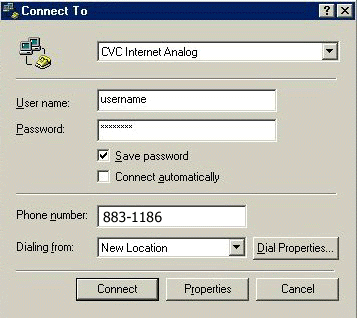
2.) If the Area Code (1-541- or 541) is showing in the Phone Number field, click on Dial Properties. Check the following:
At the bottom of the screen, click on Apply and OK to return to the Connect To window.
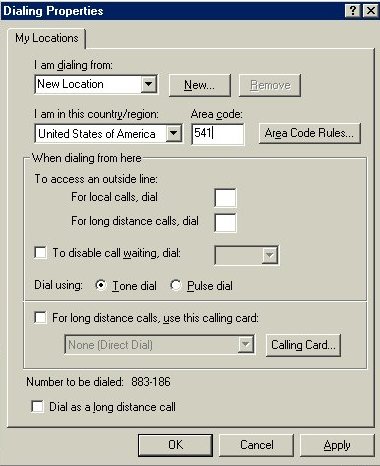
3.) At the bottom of the Connect To window, click on the Connect button. The next window to appear, will indicate the modem dialing into the server, then verifying the username and password. Once the connection is established, the connection will "drop" to the bottom right hand corner of your screen (by the clock). You are now connected to the Internet, open Internet Explorer to access the world wide web, or Outlook Express for email.

If all of the information checks fine, and an Internet connection still can't be established, re-boot your computer (close all programs, shut off computer and monitor for at least 5 minutes). Once your system has been refreshed, try re-establishing an Internet connection. If everything fails, check to see if your modem is configured correctly or not operating correctly. If the modem is not configured, contact your computer distributor and/or computer repair shop to have your modem fixed. If the modem is configured correctly and is operating correctly, please call CVC Internet to have your settings checked.
Once your dialer is working correctly, Do Not Change Your Settings! This will only cause you unnecessary problems.
Microsoft Products
- Software Technical Information -
FAQ’s Online Database
http://support.microsoft.com/directory/
Phone:
1-425-635-7222 (Windows 98/2000)
Phone:
1-425-635-7000 (Windows 95)
Phone:
1-425-635-7123 (Internet Explorer)
Phone:
1-425-637-9308 (Microsoft Programs)
<<<<< Back to CVC Internet's Help Guide
Copyright © 1996-2008, CVC Internet, LLC. All
rights reserved.
Certain
names, logos, designs, titles, words or phrases on
this site may
constitute trademarks, service marks or trade names
of CVC Internet, LLC.,
or other entities which may be registered in certain
jurisdictions.
This
web site contains links to other Internet sites, and
such links are not
endorsements of any products or services of such
sites, and no information
in
such Internet sites has been endorsed or approved by
CVC Internet, LLC.
CVC
Internet, LLC. disclaims any responsibility, if some
web site you link
to has material on it that offends you in any way.
If problems or
questions arise with the use of any of the linked
web sites, please
contact the company that owns or operates the
Internet site.